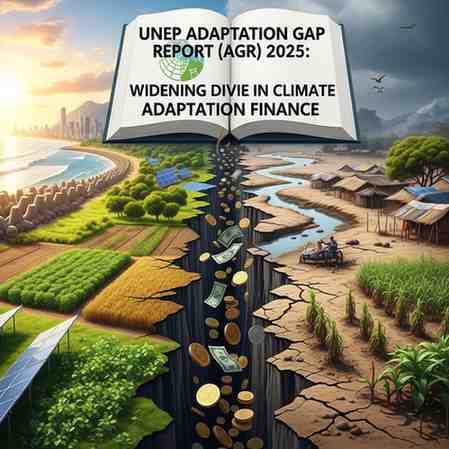
- The United Nations Environment Programme (UNEP) Adaptation Gap Report (AGR) 2025 warns of a growing global shortfall in climate adaptation finance amid worsening climate-related disasters. The report highlights that while adaptation needs are surging, funding commitments remain grossly inadequate, leaving developing nations increasingly vulnerable to floods, droughts, and rising sea levels.
Escalating Financial Needs
- According to the report, developing countries will require USD 310–365 billion annually by 2035 , a figure that rises to USD 440–520 billion after adjusting for inflation. Adaptation costs are driven by rapid urbanisation, ecosystem degradation , and the rising expense of resilient infrastructure and social protection systems . Yet, international public adaptation finance stood at just USD 26 billion in 2023 , leaving a massive annual gap of USD 284–339 billion .
- The Glasgow Climate Pact (2021) target of doubling adaptation finance to USD 40 billion by 2025 will likely be missed. UNEP also notes that the upcoming New Collective Quantified Goal (NCQG) of USD 300 billion per year by 2035 is inadequate, especially without inflation adjustments.
Unequal Burden and Limited Progress
- Developing nations continue to bear a disproportionate share of adaptation costs, with 58% of adaptation finance arriving as non-concessional loans , worsening debt stress. Although 172 countries now have National Adaptation Plans (NAPs) , 36 of these are outdated , limiting their effectiveness. Small Island Developing States (SIDS) are recognised for their strong adaptation planning despite limited resources.
Key Recommendations
UNEP calls for a Baku to Belém Roadmap to scale up global climate finance to USD 1.3 trillion annually by 2035 , aligning adaptation with sustainable development. It urges:
-
Greater private sector involvement , increasing investments from USD 5 billion to USD 50 billion annually through risk-sharing and blended finance.
-
More grants and concessional finance to avoid new debt burdens.
-
Integration of climate risk into financial systems and policies.
-
Strengthened mitigation efforts to reduce long-term adaptation costs.
India’s Adaptation Focus
- India’s strategy, led by the National Adaptation Fund for Climate Change (NAFCC) , emphasises resilience in agriculture, water, and disaster management . Upholding CBDR-RC principles , India seeks equitable climate finance while maintaining its Net Zero by 2070 target.
Exam-Oriented Facts
-
Global adaptation finance needed: USD 310–365 billion/year by 2035
-
Actual finance (2023): USD 26 billion
-
Gap: USD 284–339 billion annually
-
172 countries have NAPs; 36 outdated
-
Baku to Belém Roadmap : Finance goal
Month: Current Affairs - November 01, 2025
Category: Climate Justice, International Finance